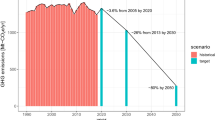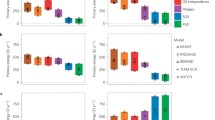Abstract
Within this paper, we present the novel hybrid model REMIND-R and its application in a climate policy context based on the EU target to avoid a warming of the Earth’s atmosphere by more than 2°C compared to the pre-industrial level. This paper aims to identify necessary long-term changes in the energy system and the magnitude of costs to attain such a climate protection target under different designs of the post-2012 climate policy regime. The regional specification of mitigation costs is analyzed in the context of globalization where regions are linked by global markets for emission permits, goods, and several resources. From simulation experiments with REMIND-R, it turns out that quite different strategies of restructuring the energy system are pursued by the regions. Furthermore, it is demonstrated that the variance of mitigation costs is higher across regions than across policy regimes. First-order impacts, in particular, reduced rents from trade in fossil resources, prevail regardless of the design of the policy regime.


















Similar content being viewed by others

Notes
On http://www.pik-potsdam.de/research/research-domains/sustainable-solutions/remind-code-1, the technical description of REMIND-R and the whole set of input data are available. REMIND-R is programmed in GAMS. The code is available from the authors on request.
We assume a pure rate of time preference of 3% for the simulation experiments presented in later sections.
The assumed values for the substitution elasticities (see Fig. 2) are comparable to the values assumed by [13, p. 49]. Regarding the nesting structure of the energy composite, we tried to replicate the basic structure of energy system services composed of mobile and stationary energy uses. Both are combined by a very low elasticity of substitution.
Most recent data are available on http://www.enerdata.fr/enerdatauk/index.html.
In cases without or with internalized externalities (applies to the climate change externality and technological learning), the pareto-optimal solution computed by REMIND-R corresponds also to a market solution.
Throughout this report, all relevant economic figures (e.g., GDP) are measured in constant international $US 2003 (market exchange rate).
The primary energy consumption of the renewable energy sources wind, solar, and hydro power is put on the same level as the related secondary energy production.
While for the year 2050, the carbon price here is of the same order of magnitude as the carbon prices simulated for the less ambitious 450 ppm CO2 stabilization scenario within the Innovation Modeling Comparison Project (cf. [7, p. 96]), it is significantly higher for the year 2100.
In general, regional GDP losses differ from regional consumption losses. This is due to the effects of international trade.
References
Alcamo, J., Leemans, R., & Kreileman, G. J. J. (1998). Global change scenarios of the 21st century. Results from the IMAGE 2.1 model. London: Pergamon & Elsevier Science.
Barker, T., Köhler, J., Anderson, D., & Pan, H. (2006). Combining energy technology dynamics and macroeconometrics: The E3MG model for climate stabilization scenarios. The Energy Journal, 113–133 (Special Issue 2006).
Bauer, N., Edenhofer, O., & Kypreos, S. (2008). Linking energy system and macroeconomic growth models. Journal of Computational Management Science, 5, 95–117.
Bosetti, V., Carraro, C., Galeotti, M., Massetti, E., & Tavoni, M. (2006). WITCH: A world induced technical change hybrid model. The Energy Journal, 13–38 (Special Issue 2006).
Crassous, R., Hourcade, J.-C., & Sassi, O. (2006). Endogenous structural change and climate targets. Modeling experiments with Imaclim-R. The Energy Journal, 259–276 (Special Issue 2006).
Edenhofer, O., Bauer, N., & Kriegler, E. (2005). The impact of technological change on climate protection and welfare: Insights from the model MIND. Ecological Economics, 54, 277–292.
Edenhofer, O., Lessmann, K., Kemfert, C., Grubb, M., & Köhler, J. (2006). Induced technological change: Exploring its implications for the economics of athmospheric stabilization: Synthesis report from innovation modeling comparison project. The Energy Journal, 57–107 (Special Issue 2006).
Edmonds, J., Wise, M., Pitcher, H., Richels, R., Wigley, T., & MacCracken, C. (1997). An integrated assessment of climate change and the accelerated introduction of advanced energy technologies. Mitigation and Adaptation Strategies for Global Change, 1, 311–339.
den Elzen, M. G. J, & Lucas, P. L. (2005). The FAIR model: A tool to analyse environmental and costs implication of regimes of future commitments. Environmental Modeling and Assessment, 10, 115–134.
den Elzen, M., Lucas, P.-A., & van Vuuren, D. (2005). Abatement costs of post-Kyoto climate regimes. Energy Policy, 33, 2138–2151.
Frei, C. W., Haldi, P., & Sarlos, G. (2003). Dynamic formulation of a top-down and bottom-up merging energy policy model. Energy Policy, 31, 1017–1031.
Gerlagh, R., & van der Zwaan, B. (2003). Gross world product and consumption in a global warming model with endogenous technological change. Resource and Energy Economics, 25, 35–57.
Gerlagh, R., & van der Zwaan, B. (2004). Sensitivity analysis of timing and costs of greenhouse gas emissions reduction. Climatic Change, 65, 39–71.
Guest, R. S., & McDonald, I. M. (2007). Global GDP shares in the 21st century—An equilibrium approach. Economic Modelling, 24, 859–877.
Hamelinck, C. (2004). Outlook for advanced biofuels. Ph.D. thesis, University of Utrecht, The Netherlands.
Höhne, N., Galleguillos, C., Blok, K., Harnisch, J., & Phylipsen, D. (2003). Evolution of commitments under the UNFCCC: Involving newly industrial economies and developing countries. Research Report, UBA-FB 000412, Umweltbundesamt.
Hourcade, J.-C., Jaccard, M., Bataille, C., & Ghersi, F. (2006). Hybrid modeling: New answers to old challenges. The Energy Journal, 1–12 (Special Issue 2006).
Kahouli-Brahmi, S. (2008). Technological learning in energy-environment-economy modelling: A survey. Energy Policy, 36, 138–162.
Kainuma, M., Matsuoka, Y., & Morita, T. (2003). Climate policy assessment: Asia-Pacific integrated modeling. Tokyo: Springer.
Kouvaritakis, N., Soria, A., & Isoard, S. (2000). Endogenous learning in world post-Kyoto scenarios: Applications of the POLES model under adaptive expectations. International Journal of Global Energy Issues, 14, 222–248.
Kriegler, E., & Bruckner, T. (2004). Sensitivity of emissions corridors for the 21st century. Climatic Change, 66, 345–387.
Kypreos, S., & Bahn, O. (2003). A MERGE model with endogenous technological progress. Environmental Modeling and Assessment, 19, 333–358.
Leimbach, M., & Toth, F. (2003). Economic development and emission control over the long term: The ICLIPS aggregated economic model. Climatic Change, 56, 139–165.
Löschel, A. (2002). Technnological change in economic models of environmental policy: A survey. Ecological Economics, 43, 105–126.
McKibbin, W. J., & Wilcoxen, P. J. (1999). The theoretical and empirical structure of the G-cubed model. Economic Modelling, 16, 123–148.
Manne, A. S., Mendelsohn, M., & Richels, R. (1995). MERGE—A model for evaluating regional and global effects of GHG reduction policies. Energy Policy, 23, 17–34.
Manne, A. S., & Rutherford, T. (1994). International trade, capital flows and sectoral analysis: Formulation and solution of intertemporal equilibrium models. In W. W. Cooper, & A. B. Whinston (Eds.), New directions in computational economics (pp. 191–205). Dordrecht: Kluwer.
Mas-Colell, A., Whinston, M. D., & Green, J. R. (1995). Microeconomic theory. New York: Oxford University Press.
Messner, S., & Schrattenholzer, L. (2000). MESSAGE-MACRO: Linking an energy supply model with a macroeconomic model and solving it interactively. Energy, 25, 267–282.
Nordhaus, W. D., & Yang, Z. (1996). A regional dynamic general-equilibrium model of alternative climate-change strategies. American Economic Review, 86, 741–765.
Petschel-Held, G., Schellnhuber, H. J., Bruckner, T., Toth, F. L., & Hasselmann, K. (1999). The tolerable windows approach: Theoretical and methodological foundations. Climatic Change, 41, 303–331.
Penn World Tables (2007). Version 6.2. http://pwt.econ.upenn.edu/php-site/pwt-index.php.
Riahi, K., Grübler, A., & Nakicenovic, N. (2007). Scenarios of long-term socio-economic and environmental development under climate stabilization. Technological Forecasting and Social Change, 74, 887–935.
Rogner, H. H. (1997). An assessment of world hydrocarbon resources. Annual Review of Energy and Environment, 22, 217–262.
Rose, A., & Stevens, B. (1993). The efficiency and equity of marketable permits for CO2 emissions. Resource and Energy Economics, 15, 117–146.
Sanstad, A. H., & Greening, L. A. (1998). Economic models for climate policy analysis: A critical discussion. Environmental Modeling and Assessment, 3, 3–18.
Takeshita, T., & Yamaij, K. (2008). Important roles of Fischer-Tropsch synfuels in the global energy future. Energy Policy, 36, 2773–2784.
Vaillancourt, K., Loulou, R., & Kanudia, A. (2008). The role of abatement costs in GHG permit allocations: A global stabilization scenario analysis. Environmental Modeling and Assessment, 13, 169–179.
World Bank (2005). World development indicators. Washington, DC: World Bank.
Weyant, J. P. (2004). Introduction and overview. Energy Economics, 26, 501–515.
Acknowledgements
For their help in implementing the REMIND model, we are grateful to our colleagues Michael Lüken and Markus Haller. We also thank the German Federal Environmental Agency for the financial support of this research.
Author information
Authors and Affiliations
Corresponding author
Rights and permissions
About this article
Cite this article
Leimbach, M., Bauer, N., Baumstark, L. et al. Mitigation Costs in a Globalized World: Climate Policy Analysis with REMIND-R. Environ Model Assess 15, 155–173 (2010). https://doi.org/10.1007/s10666-009-9204-8
Received:
Accepted:
Published:
Issue Date:
DOI: https://doi.org/10.1007/s10666-009-9204-8



